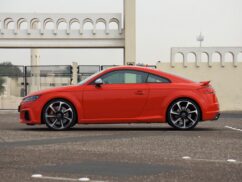2018 Audi TT RS
| The Good: – Stylish inside and out – Decent daily driver – Stable dynamics and power |
The Bad: – Fiddly multimedia system – Useless back seat – Not playful enough |
The first generation of the Audi TT was a design icon. It looked like a concept car for the road, and hid its VW Golf-based roots well. It was also a death trap, suffering from lift-off oversteer due to its wing-like design (like an early Porsche 911), prompting Audi to add a little lip spoiler to later models. The second-generation model evolved from that original shape with a pop-up rear spoiler now, although it didn’t feel “original” like the original any more. The third generation mostly carried over similar styling even though it’s an all-new model, with an angrier snout and sharper detailing. In the summer of 2019, Audi announced that this will be the last generation for the TT and there will be no replacement when production ends. Unfortunately the TT range was killed off in the Middle East anyway by the end of 2018, but not before offering the fastest-spec TT RS for that final year, which we had a chance to drive.
The TT RS is a great-looking car, with enough body kit bits tacked on to make sure it isn’t mistaken for a base model. It has bigger bumper vents, a taller fixed rear spoiler, larger exhaust tips and optional 20-inch alloys that look like the blades of a blender. The third-gen TT also came with standard LED headlights and – in an industry first – very cool OLED tail lights.
You don’t have to contort yourself too much to get into this sports car. The most attractive beneficiary of the VW Golf platform has more than enough headroom and cup-holders for front passengers, although the rear seats are limited to teddy bears and hand bags. And there is an average-sized boot under the wide-opening rear glass hatch, enough for a weekend grocery run.
The interior trim is premium, the doors and centre-console are covered in soft-touch materials, and the leather upholstery on the well-bolstered seats is befitting the brand. Nice little touches include the digital a/c temperature displays embedded within the circular vents themselves, the alcantara door inserts, the slivers of carbon-fibre trim, and the flat-bottomed steering wheel with Ferrari-style buttons built in.
While you can’t see a whole lot out of the back windows, the forward visibility is great thanks to a low dashboard. But that was achieved by removing the typical centre-console infotainment screen and moving everything to the full-LCD 12.3-inch gauge-cluster display. This causes some issues though, such as having to peer at the rear camera view through the spokes of the steering wheel as you turn it. Otherwise all screen-based techy features are covered — Bluetooth, navigation, all-round parking sensors with visual warnings etc. A banging Bang & Olufsen stereo is also part of the package, but active driving aids are limited, at least in the version we drove.
The Audi TT RS coupé comes with a 5-cylinder 2.5-litre “TFSI” turbo engine making 395 hp at 5,850 rpm and 480 Nm of torque from just 1,700 rpm. Audi’s all-wheel-drive quattro system is the standard layout and the only gearbox option is the 7-speed “S-tronic” automatic with paddle-shifters. With all that firepower, the car is supposed to do 0-100 kph in a claimed 3.7 seconds, but we only managed 4.6 seconds, which is still extremely quick. Maybe someone filled it up with RON95 “Special” petrol instead of the required RON98 “Super” fuel before we got the car, which incidentally burned at a rate of 12.3 litres/100 km (8.1 km/litre).
At least the unusual 5-cylinder configuration sounds interesting, giving it a deep, grunty soundtrack compared to mainstream 4-cylinder engines, with an exhaust pop on deceleration downshifts.
The Drive Select system can alter the steering weight, gearbox shift points, engine response and exhaust note via Comfort, Auto, Dynamic and Individual modes.
The gearbox offers reasonably quick shifts, and when combined with an instant throttle response, it is quite fun to drive. The handling is flat and the cornering grip is impressive. Expectedly, the TT RS understeers at the limit when the 245-width tyres finally run out of grip, and while the all-wheel-drive laden chassis makes it easy to explore its outer limits, some oversteer would’ve been welcome in this kind of chuckable car. There is no tail-wagging action whatsoever.
The steering is sharp and well-weighted, but offers very mild feedback. The brakes offer good stopping power, but is not as strong as we expected for a little supercar.
On the daily churn, the lowered TT’s ride is firm but bearable. External noises are moderate at highway speeds below 120 kph.
The TT RS is easily among the most desirable Audis we’ve driven in a very short list that includes the previous-gen R8 V10 and the RS wagons. We think the problem is it isn’t at the top of anyone’s list of sports cars, as its image has been diluted by the basic TT models. It was still a more interesting offering compared to the deluge of crossovers. The TT left the region a couple of years ago, and the Audi showroom floor feels emptier for it.
| Price Range: Dh 306,000-308,000 Current Model Introduced in: Body Styles: Engines: Transmissions: Setup: Suspension: |
Brakes: Front: discs Rear: discs Curb Weight: Length: Wheelbase: Top Speed: Test Acceleration 0-100 kph: Observed Test Fuel Economy: |
















There are no comments. Be the first!